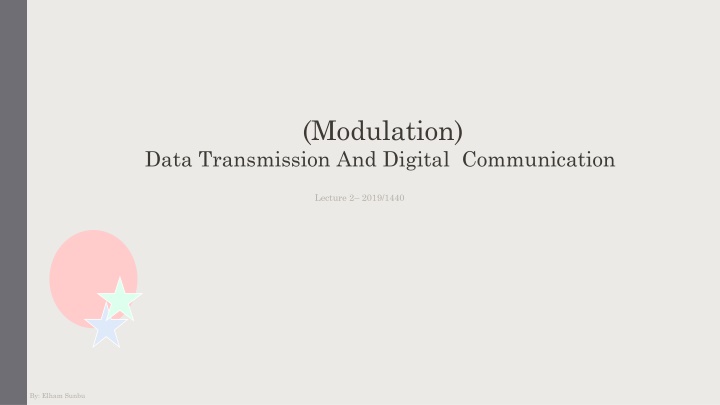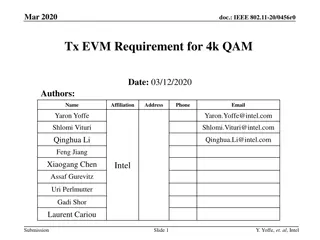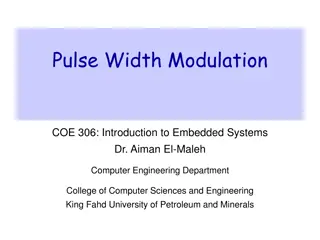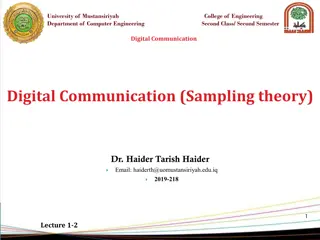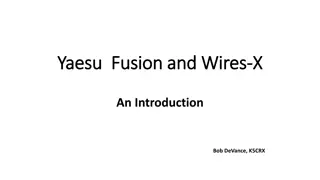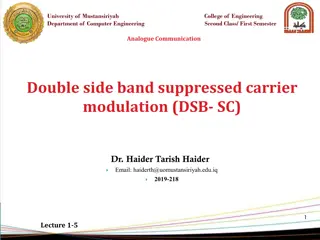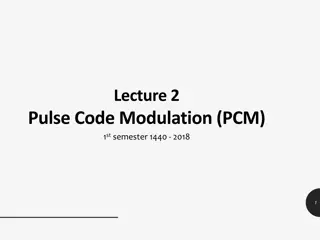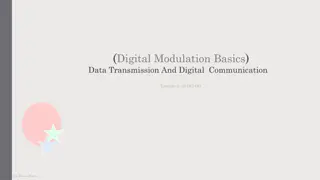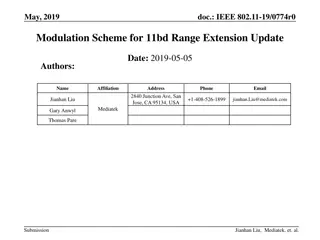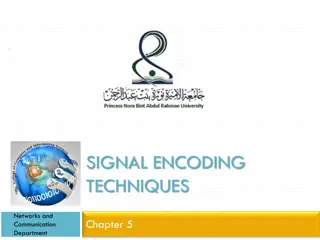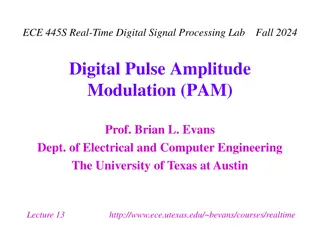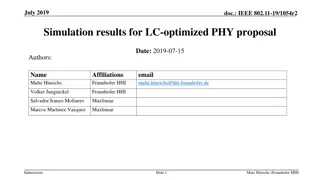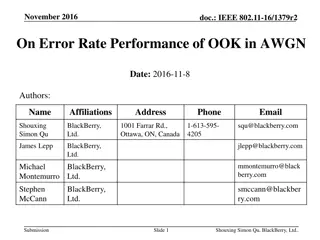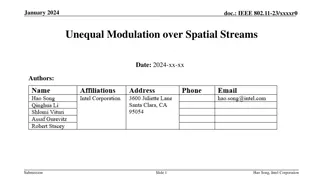Modulation in Data Transmission and Digital Communication
Modulation plays a crucial role in data transmission and digital communication by altering the characteristics of a carrier signal based on the message signal. This lecture discusses analog and digital modulation techniques such as AM, FM, PM, and their operations. It covers the basics of amplitude modulation (AM), frequency modulation (FM), phase modulation (PM), and the standard AM modulation criteria. Additionally, it explores the concept of modulation index and its importance in signal demodulation.
Download Presentation

Please find below an Image/Link to download the presentation.
The content on the website is provided AS IS for your information and personal use only. It may not be sold, licensed, or shared on other websites without obtaining consent from the author.If you encounter any issues during the download, it is possible that the publisher has removed the file from their server.
You are allowed to download the files provided on this website for personal or commercial use, subject to the condition that they are used lawfully. All files are the property of their respective owners.
The content on the website is provided AS IS for your information and personal use only. It may not be sold, licensed, or shared on other websites without obtaining consent from the author.
E N D
Presentation Transcript
(Modulation) Data Transmission And Digital Communication Lecture 2 2019/1440 By: Elham Sunbu
OUTLINE Modulation Analog Modulation. AM FM PM Digital Modulation.
Modulation Operation of varying amplitude, frequency or phase of carrier signal accordingly with the instantaneous amplitude of the message signal.
Modulation Types Analog modulation Digitalmodulation
Analog Modulation AnalogModulation: Baseband signalisalways analogforthismodulation.Thereare three properties of a carrier signal amplitude, frequency and phase thus therearethreebasictypesofanalogmodulations. Amplitude Modulation(AM) Frequency Modulation(FM) Phase modulation(PM)
Amplitude Modulation(AM) - The Modulating Signal (message or baseband signal) (t ) m - The Carrier Signal is = 2 cos( where ) t f c c c - The Modulated Signal = + ( ) cos( A c ) ( cos( t c ) ) S t A = t m t t AM c c c + ( ) cos( ) m t 8
Standard AM Modulation - The envelope of the modulated signal has the same shape as the baseband signal provided the following two requirements are satisfied 1. The carrier frequency fc must be much greater then the highest frequency components fm of the message signal m(t) i.e. fc >> fm 2. The modulation index must be less than unity; if the modulation index is greater than unity, the carrier wave becomes over modulated. 11
Modulation Index - Let Am the peak amplitude of m(t)and Ac is the carrier amplitude. - The modulation index is defined as: A = m A c 0 1 - The is a required condition to do the demodulation. 12
Demodulation - In the standard AM modulation, the modulation index should be in order to demodulate the received modulated signal by using an envelope detector. 14
Frequency Modulation (FM) is a process of changing the frequency of a carrier signal in accordance with the message signal (modulating signal).
FM Modulation - Note that there are no amplitude variations in the FM. - The envelope of an FM modulated signal is a constant. 17
FM Modulation Frequency modulation (FM) and phase modulation (PM) are types of what is called Angle modulation. The FM and PM characterized by their superior performance (compared to AM) in the presence of noise at the expense of higher bandwidth requirements. 18
Angle Modulation - Consider a sinusoid: Ac cos ( ct+ ) where 1.Ac is the (constant) amplitude, 2. c is the (constant) frequency 3.and is the initial phase. Let the sinusoid be written as: where (t) = ct+ . Ac cos [ (t)] 19
FM Modulation - In frequency modulation the angle (t) is varied linearly with the integral of message signal m(t) as: t = + ( d ( ) ) t t k m c f where kf is the frequency deviation. - Thus the frequency modulated signal is defined as: t = + ( d ( ) cos ) S t A t k m FM c c f 20
FM Modulation - In Frequency modulation, the frequency of a carrier signal deviates from its center frequency by an amount that is proportional to the message signal amplitude. - FM uses the message signal, m(t), to vary the carrier frequency within some small range about its original value. 21
FM Modulation - Frequency deviation is the positive or negative change in the carrier frequency from its center frequency. - When the message signal amplitude is zero, there is no change in the FM carrier frequency; the carrier is at its center frequency. 22
FM Modulation - An FM modulated signal has its instantaneous frequency that varies linearly with the amplitude the message signal. 23
PM Modulation - In phase modulation (PM), the carrier signal changes its phase with the changes in the message signal amplitude. - FM and PM are types of what is called Angle modulation. 25
PM Modulation - FM and PM are interrelated; one cannot change without the other changing. - In FM, the frequency of a carrier signal deviates from its center frequency by an amount that is proportional to the message signal amplitude. - In PM, the frequency (and phase) of a carrier signal changes by an amount that is proportional to the message signal amplitude and frequency. 27
PM Modulation - FM requires the carrier s frequency to deviate both above and below its center frequency. - During the process of frequency modulation, the peaks of each successive cycle in the FM modulated waveform occur at times other than they would if the carrier were un modulated. - This is actually an incidental phase shift that takes place along with the frequency shift in FM. 28
PM Modulation - Just the opposite action takes place in phase modulation. - Notice that the time period of each successive cycle varies in the modulated wave according to the audio-wave variation. - Since frequency is a function of time period per cycle, we can see that such a phase shift in the carrier will cause its frequency to change. 29
PM Modulation - In Frequency modulation, the frequency of a carrier signal deviates from its center frequency by an amount that is proportional to the message signal amplitude. - FM uses the message signal, m(t), to vary the carrier frequency within some small range about its original value. 30
Digital Modulation Digital Modulation: Digital modulation in somewhat similar to the analog modulation except base band signal is of discrete amplitude level. For binary signal it has only two level, either high or logic 1 or low or logic 0. The modulation scheme is mainly three types. 1. ASK or Amplitude shift Key 2. FSK or Frequency shift key 3. PSK or Phase shift key
Thank You 33
